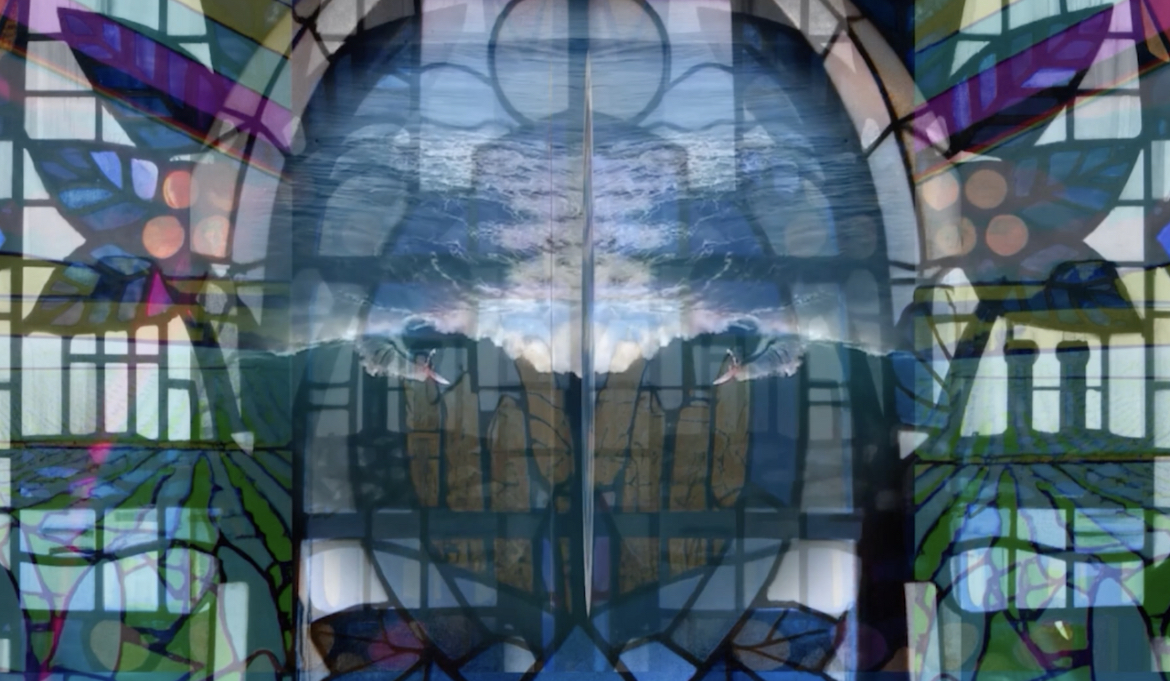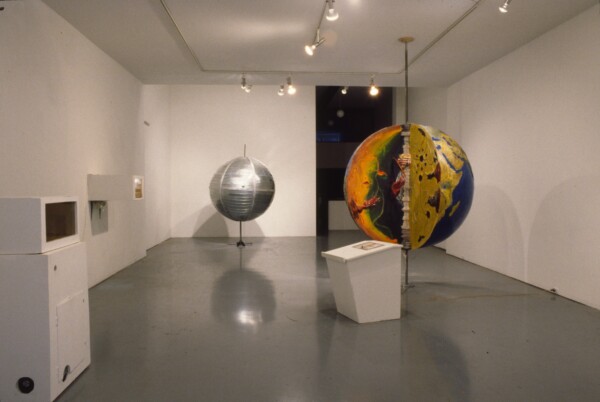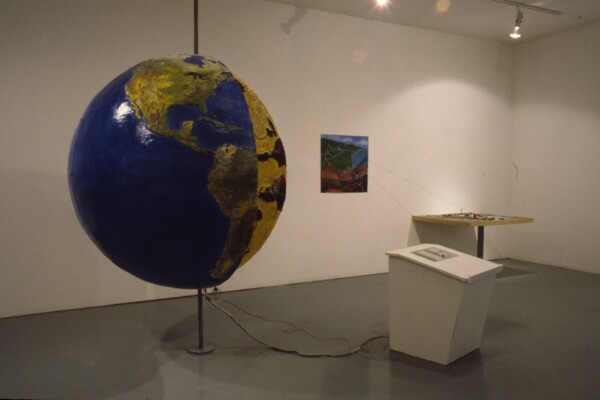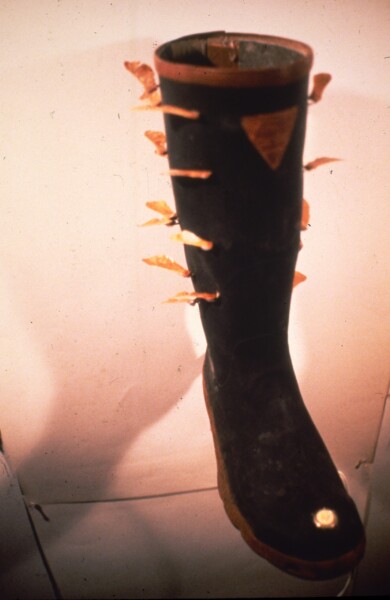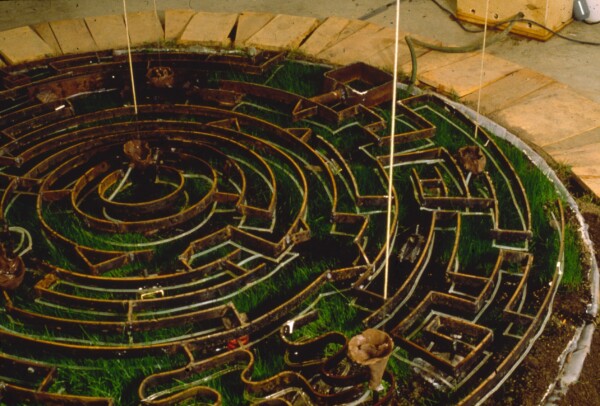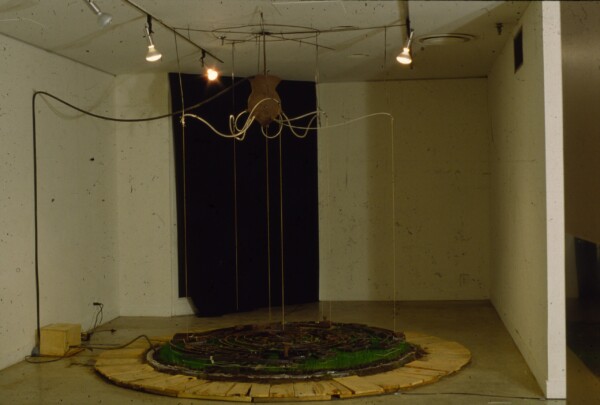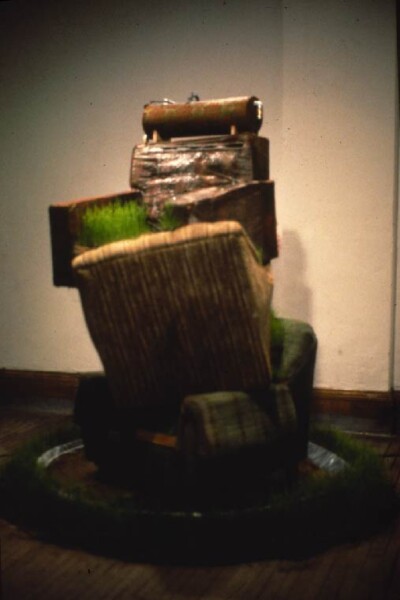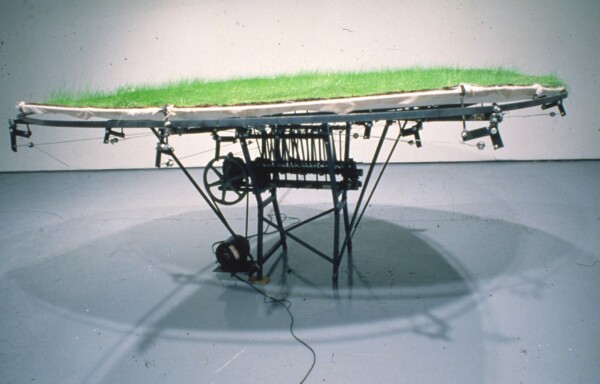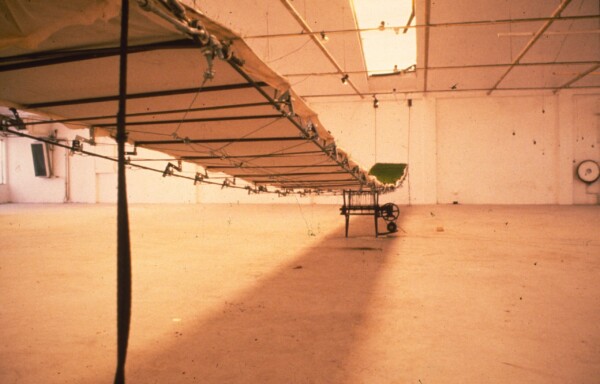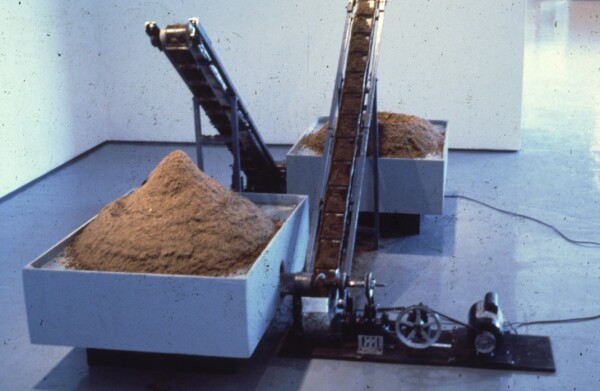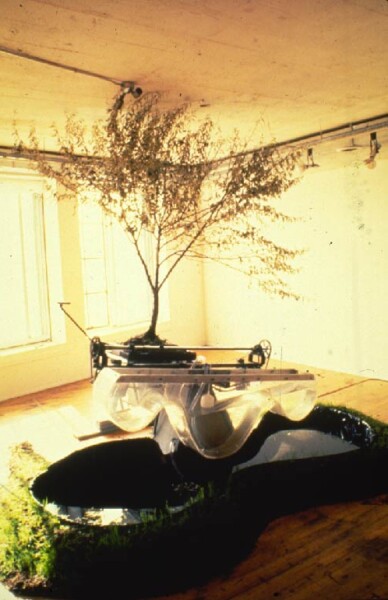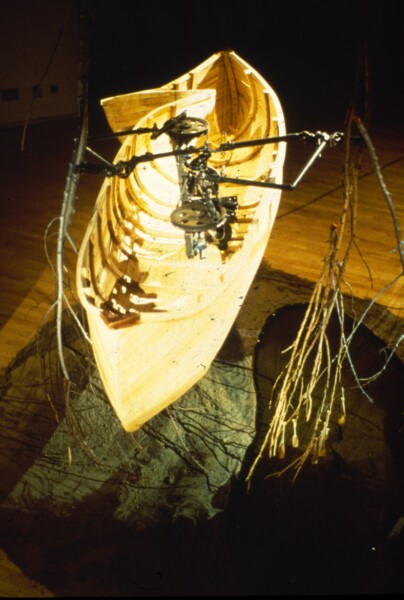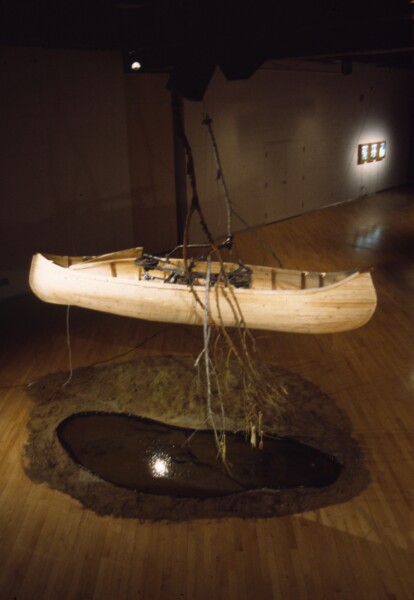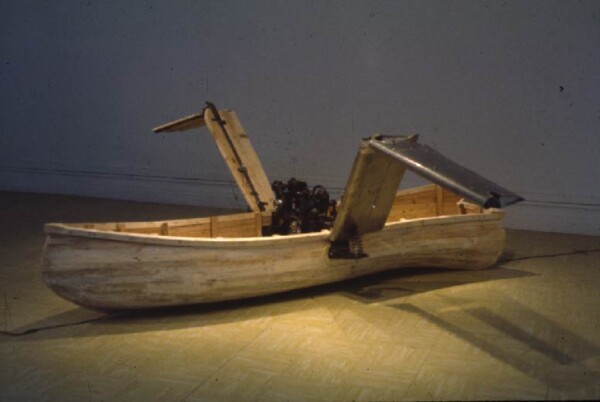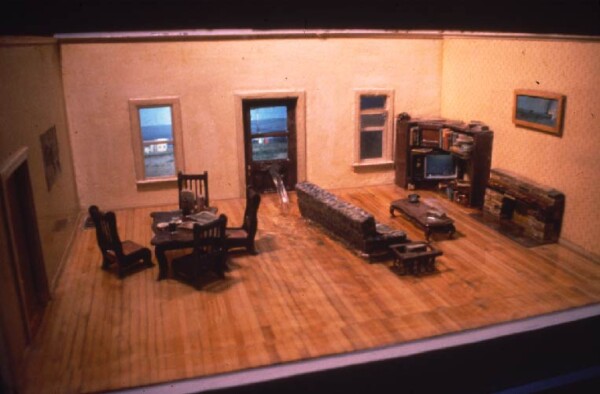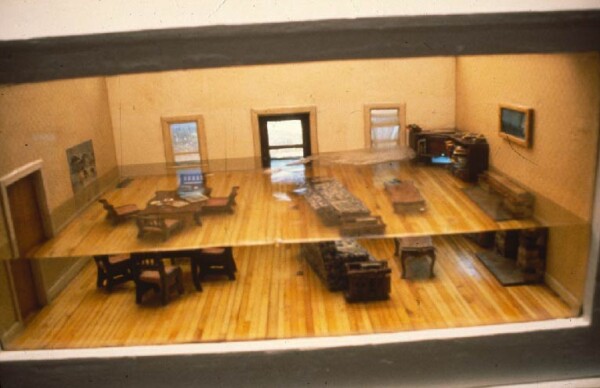- Home and Oasis –Doug Buis
- Home and Oasis –Doug Buis
- Home and Oasis –Doug Buis
- Home and Oasis –Doug Buis
Home and Oasis
Doug Buis
15 October–
12 November 1994
Curated by: Janis Bowley


Doug Buis: Home and Oasis, 1994. Courtesy of the artist.


Doug Buis: Home and Oasis, 1994. Courtesy of the artist.


Doug Buis: Home and Oasis, 1994. Courtesy of the artist.


Doug Buis: Home and Oasis, 1994. Courtesy of the artist.


Doug Buis: Home and Oasis, 1994. Courtesy of the artist.


Doug Buis: Home and Oasis, 1994. Courtesy of the artist.


Doug Buis: Home and Oasis, 1994. Courtesy of the artist.


Doug Buis: Home and Oasis, 1994. Courtesy of the artist.
Home and Oasis
Doug Buis
Curated by: Janis Bowley
Press Release:
The Or Gallery is pleased to introduce the work of Montreal based artist Doug Buis to Vancouver audiences.
Home and Oasis is a grouping of new and previously exhibited constructions. Buis scans popular media, political events, technological and scientific trends, focusing on the micrcosms and macrocosms within these consepts. He has created a series of ‘hand-crafted virtual realities’ in the form of small portable live gardens- Biycle Garden, Lap-top Garden and Dot-matrix Planter. There are also two depictions of the Earth; one which is part of Buis’ “neo-Geo’ series and models, in science museum aesthetic, our planet with an exposed organic interior of muscles, organs and nervous system. The politics of ‘green consumerism’ comes into focus in his other model of an entombed planet in ‘Earth with Protective Cover’/ Buits’ involvement in the controversy surrounding the siting of a propsed hydro-dam at Great Whale, Quebec and his concern about conflicting cultural priorites about conflicting cultural priorities, created a series of model home interiors which relentlessly flood and drain.
Doug Buis uses viewer participation, mechanical and electronic devices to increase our awareness of his subject matter. He exposes the humour and absurdity within the issues he depicts and illuminates the often arbitrary nature of Western belief systems.
The artist will be in attendance at the opening where he will be available to talk about the work. The gallery’s publication for this exhibition has been produced as a component of the installation.
Home and Oasis
The following text contains condensed excerpts of an article that appeared in the September, 1994 issue of SCIENCE AMERICA, concerning the recent geological discoveries by a team headed by Dr. Jane Knott-Guya. Dr. Knott-Guya began her research following the detection of what seemed to be a heart beat off the coast of California. Numerous theories arose as to the origin of the geological pulses, with no real answers until the astounding discoveries of the Knott-Guya team. The findings, including musculo-stratic tissue, parts of mechani-organic hydraulic systems and evidence of a silicon -based nervous system, have changed our world view as profoundly as the discovery of the spherical format of our planet. They have also sparked intense and, at times, acrimonious debate as to the exact organic structure of the earth. The following article is an overview of the debates surrounding this issue. The geo-models presented in this display illustrate the most widely held beliefs, although many are controversial. The models were made by sculptor Doug Buis.
The discoveries of Dr. Knott-Guya have turned the geological world on it’s ear. A few diehard geologists still maintain the view of a mineral based earth, suggesting that the artifacts are remnants of large, subterranean animals or of an extinct underground race of humanoids. Although there have been some compelling arguments put forth by the mineral-earth believers, they have generally been debunked. The true picture, however, is less than clear. One recurring facet of the debate (and one of the problems) has been the constant anthropomorphising of the earth’s functions. Although the comparisons to the human systems are perhaps inevitable, the biological systems of the earth are quite different from our own. Some experts question whether the earth itself is actually a living entity.
One would assume that the first point of investigation would have been the geological nervous system and the possibility of the earth being sentient. Probably due to the interest over the heartbeat phenomena, however, the first area of study concerning the geo-structure of the earth has been the circulatory systems. Few geotheories disagree on one point; there being at least three separate systems of circulation: the blood-like system of lava, the water-based system and the oil (petroleum) based system. Of the three, the latter (oil) is the least contentious. Most geo-experts agree that oil, functioning similar to our own hydraulic mechanical systems, drives most of the organo-mechanical structures particularly those requiring massive kinetic shifts in position. The bio-strata lateral movement muscle, also known as the earthquake muscle, utilizes a mechanism similar to a piston / crankshaft coupling. There are some arguments suggesting that water is the driving force behind the muscular systems considering the huge quantities needed for proper functioning of the systems. The low evaporative threshold of water precludes this as a probability, however. One role of water, particularly rivers, appears to be within the earth’s digestive system, perhaps to carry away the waste products.
There is some controversy as to the function of cities (or the broader question of the role of humanity for that matter). The two most widely accepted theories are also the two furthest apart. The more popular of the two theories is that of cities being part of the earth’s nervous system. The other popular theory (more interesting although less popular perhaps because of the nature of the theory and a natural bias against it) is that of the city as a form of skin irritation or dermal condition. The skin irritation theory is given a considerable boost in light of the probable function of earthquakes as a irritation response, not unlike a dog scratching behind it’s ear. There appears to be a considerable number of earthquakes (let alone a significant number of other ‘natural’ disasters) occurring in some of the more polluted global regions. When viewing cities from above, one can detect a resemblance to computer systems; a similarity extending to the nervous system of the earth itself. This leads to the question of whether or not the city is a nodule or closeknit cluster of nerve endings. Interestingly, both theories about the function of cities suggest the existence of an intelligent nervous system.
There is ample evidence from the core samples, to suggest a silicon based nervous system and hence the likeness to computer chips. How messages are transmitted is not certain, but one likely option is the metallic veins (i.e. a nickel vein) networking beneath the earth’s surface. (One wonders what the effect that mining has had on the nervous system.) How metallic veins and nodules interface is uncertain. One hypothesis assumes that the veins are connected through the sewer systems or underground wires and electrical systems, presupposing that humanity is an integral part of the earth organism.
The issue which has aroused the greatest interest and debate, not surprisingly considering general interests in this field, is the earth’s reproductive system. Some argue that the organic structures organized spontaneously within a natural rock planet independent of other planets. The other theory considers the idea of an earth spawned from other planets which immediately brings up the chicken / egg syndrome; how did the first reproducing planets appear? The two theories, incidentally, are not entirely mutually exclusive. One can imagine life occurring at one point within the planetary structure and eventually developing reproductive capabilities. This scenario, however, suggests a time frame many times longer that the generally accepted age of the universe.
T.L. Kerr discusses the function of gravity in the reproductive system: “… as volcanoes spew the genetic material into space, very little of the actual matter escapes the gravitational bond of the earth allowing only the strongest to survive. The free floating matter, with its’ own weak gravitational field, collects passing dust and other random material and over eons forms a bud planet. (Our own moon being one such example.)”
A debate has arisen in some circles as to the gender of the earth and of the various entities donating the dust and other materials. Geo-biologist Dr. G.H. Ellism of the Stanford Research Labs states: “If we intend to use the traditional biological model referred to in general and gender differentiation in particular, it seems clear that the earth, as it emits the ova-like projectiles into space, which then attract the passing sperm-like dust, is by definition female. As the sun generates most of material collected by the ova, it would have to be considered as the male counterpart.”
Many have suggested that Dr. Ellism’s comments, aside from an inherent sexist slant, are based on a simple arbitrary mechanical likeness of the volcanic projectiles and ova with little, if any, biological justification. One could also equate the propulsive action of the volcano with that of ejaculation. He does get some support from Ms. Carol Morgan who, taking a relational rather than physical structurist stance, states:
“In considering the moon as a bud planet, we cannot dismiss the long-term relationship that has developed between the earth and it’s satellite. If we compare it to a mother / child relationship, we see the child residing for an extended time period within the local sphere of influence of the mother. In a geological time frame, the moon had spent a similar length of time clutching to it’s mother’s apron.”
Most theorists tend to discuss the gender-typing of the earth as simplistic, yet in some ways predictable, as we seem unable to avoid athropomorphising the geological lifesystems.
Home and Oasis: Doug Buis (2.52 MB)
Essay:
Espace Magazine #31, Spring 95 by Michael Molter, pg 22
Art Papers, March/April 95 by John K. Grande, pg. 64
